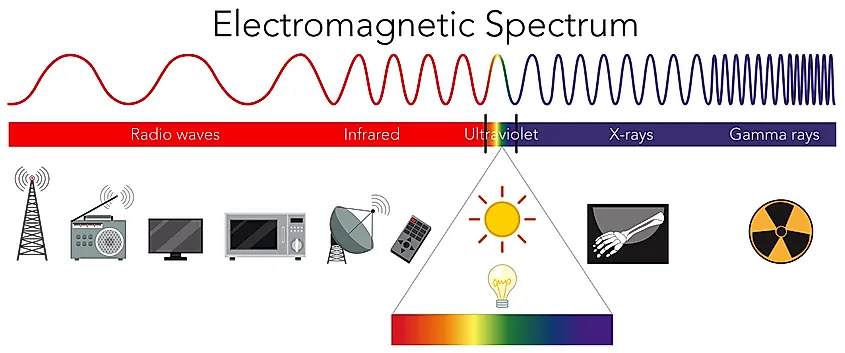
The Electromagnetic Spectrum
We humans have evolved the ability to capture light in our eyes and relay the message to our brain, which then creates an image of what it is we’re seeing. We are not the first nor the only species to do this. Eyes have existed on Earth for many hundreds of millions of years. For most organisms, eyes have evolved to see in a very specific type of light. We call this light visible light, which as the name suggests, is the light that our eyes can see. However, it isn’t the only light out there. There exists a spectrum housing all forms of light in the cosmos. Called the electromagnetic spectrum, it begins with radio waves and ends with gamma rays.
Wavelengths And Energy

Different forms of light are characterized by different wavelengths. Like sound, light travels in waves, with the length of those waves determining the energy of the light. The longer the wavelength, the lower the energy. The shorter the wavelength, the higher the energy. Light with a shorter wavelength will have a higher frequency since the distance between individual wave crests will be shorter. Longer wavelengths of light will have a lower frequency because the distance between wave crests is longer. An easy way to visualize this is to think of waves on the ocean. If the distance between wave crests is short, you will be hit by more waves over a shorter period of time, and thus the waves would have a higher frequency. If the distance between wave crests is longer, then you will be hit by a lower number of waves over a longer period of time, and thus the waves are of a lower frequency.
Differences in wavelength also translate to color, with longer wavelengths shifting towards red and shorter wavelengths shifting towards blue. Whenever you see a rainbow, you’re seeing a visual representation of these differences. Radio waves have the longest wavelength, followed by microwave, infrared, visible, ultraviolet, x-rays, and gamma rays. The further along you move, the higher the energy of the light.
The light that our sun emits happens to peak in the visible section of the electromagnetic spectrum. Thus it shouldn’t come as much surprise that our eyes and most other eyes have evolved solely to see in this wavelength of light. However, this also means that our eyes are unable to see any other wavelength of light. In fact, the visible part of the spectrum comprises a mere 0.0035% of the total area on the electromagnetic spectrum. Our eyes are unable to see 99.9965% of the electromagnetic spectrum. That means that nearly 100% of light is entirely invisible to our eyes. We can only see the tiniest sliver of light, yet that itself has been enough for the majority of life forms on Earth.
How Different Wavelengths Are Produced

Different wavelengths of light are produced by different processes and events. Low energy events produce longer wavelengths of light while high energy events produce shorter wavelengths of light. There are actually very few things in the universe that emit light in the wavelengths that our eyes can see. If you wish to watch the formation of a star deep within an interstellar cloud, you must see it in infrared because the longer wavelength of infrared light can pass through densely packed clouds of stellar material. Otherwise, the entire process is invisible. If you wish to see a star explode in a mighty supernova, you must see it in shorter wavelengths of light such as ultraviolet and gamma ray, otherwise it’s invisible to you. Our eyes are unable to see the birth and death of the stars. However, humanity has been remarkably clever at overcoming these problems. Our innovative minds have allowed us to create filters and detectors that allow us to capture and see in other wavelengths of light. Using our technology, we are now able to see the cosmos in every wavelength of light. Just using our eyes, however, still means we’re blind to the cosmos. It is truly amazing how stunning the natural is even though our eyes are unable to see most of it.











